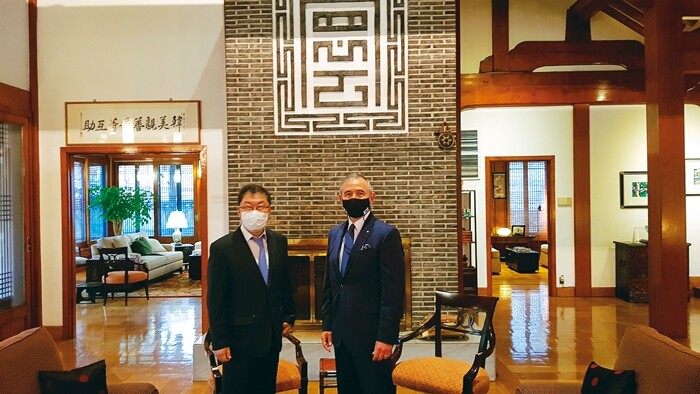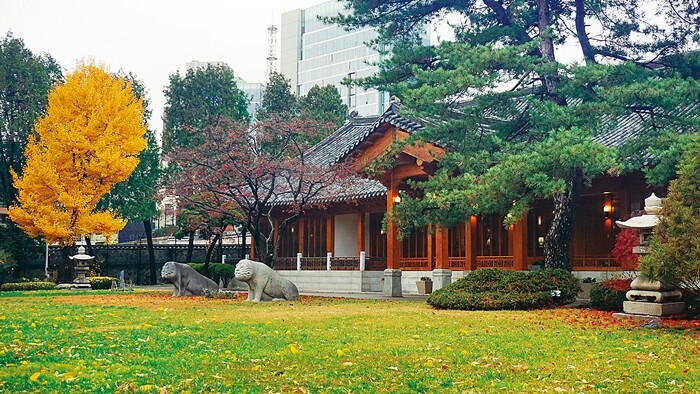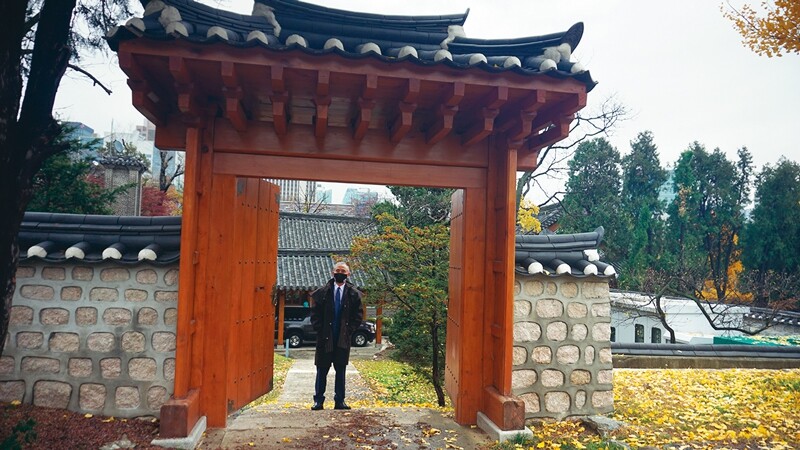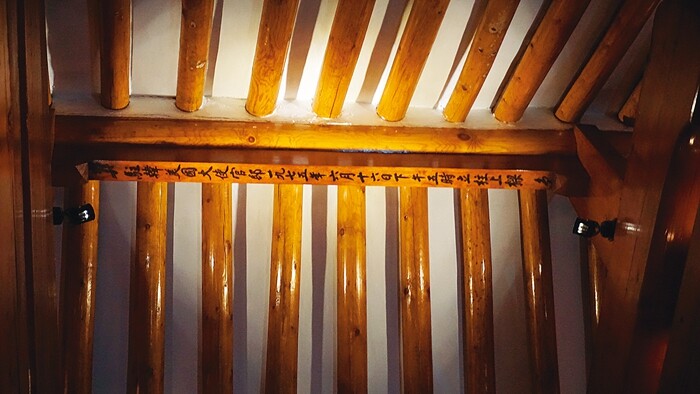hankyoreh
Links to other country sites 다른 나라 사이트 링크
[Seoul travels] Coffee with US Ambassador Harry Harris

Coffee is a magical beverage. It helps us not only shake off our sleepiness and mental fog, but also endure the tedium and fatigue of the COVID-19 era.
Once again, I found coffee casting its magical spell. On one day in November, when the golden spectacle of late fall was drawing to a close, I got a call from an unfamiliar number.
“What would you say to visiting the American ambassador’s residence for a private cup of coffee with the ambassador?”
Any travel writer worth his salt pays more attention to what’s unseen than seen and lends an ear to locals’ stories. Not only is the American ambassador’s residence one of the most challenging places to get into in Seoul, but here I was being invited to a one-on-one with the ambassador himself. No way I was going to turn that down!
But why me, a lowly travel writer who wanders around the streets of Seoul? Why not some influential journalist or CEO?
The staff at the residence explained that US Ambassador Harry Harris had decided to invite me over after reading some of my pieces about exploring the back streets of Seoul here on the Hankyoreh’s English-language website. (The Korean-language originals in my “Seoul travels” series appear on Seoul&, a webzine about life in Seoul.)

The American ambassador’s residence is on Jeongdong Street, in downtown Seoul. This neighborhood is where Western culture — including coffee, which was then called “yangtangguk,” meaning Western soup — first arrived in Seoul at the tail end of the Joseon Dynasty.
The American ambassador’s residence played a role in that process, and now I was being given a chance to drink “yangtangguk” in that very place.
I wanted to stay nonchalant, but I couldn’t help shouting, “Why not?
To reach the ambassador’s residence, one has to walk from City Hall Station to the area behind Deoksu Palace, following the stone wall that surrounds the palace.
American writer Anatole Broyard once observed that cities are the source of poetic inspiration, and this part of Seoul could turn anyone into a poet or artist. Because of the stone wall and the human scale of the road, Jeongdong Street caters to our analog sensibilities.
After passing a police detail and a rigorous security check, the massive iron doors swung open. Ambassador Harris greeted me with a broad smile.
Harris was wearing a mask as a precaution against COVID-19, but I felt like I’d known him for a long time, perhaps because I’d often seen him on TV. He suggested that we start out by taking a look around the garden at the residence.

The ambassador’s residence consists of buildings and land purchased by the first American minister to Korea, who was assigned to his post after the Joseon-US Treaty of 1882, Korea’s first treaty with a Western power. Two hanok (traditional buildings) stand on a low hill in beautiful harmony with their surroundings.
The residence is not imposing but unassuming, which is a big part of its charm. The site contains a neatly tended garden for outdoor receptions, an outdoor tennis court, and a swimming pool. There’s even a vegetable garden in the direction of Jeongdong Park, where the old Russian legation used to stand.
The small hanok on the right as one enters the complex is called the Legation House. Built in 1883, this was used as the residence first of the minister and then of the consul. Since being restored in 2004, it has been used as a reception hall.
Prominently standing to the left is a somewhat larger hanok structure with striking wooden pillars under its tiled roof. This is Habib House, the ambassador’s residence. In front of the building are two stone statues of haetae, mythical creatures said to protect against fires and malign influences.
At the entrance to the building is a wooden panel engraved with the names of Harris and his wife, Bruni Bradley. Next to that is a large bronze plaque in the memory of Philip Habib, the man for whom the residence was named.

Philip Habib served as American ambassador to South Korea from 1971 to 1974. When it came time to build a new residence to replace the old one, which had grown decrepit, Habib insisted that Korea’s traditional architectural style be maintained, in light of the historical significance of the site and its scenic surroundings.
Habib’s idea faced staunch opposition from the US State Department, which had a tradition of building ambassadors’ overseas residences in an American style. But Habib ultimately got his way by emphasizing the special relationship between South Korea and the US and the residence’s symbolic location behind Deoksu Palace.
Since the building wasn’t completed until 1976, Habib himself never got to use it. Donald Gregg, who served as US ambassador from 1989 to 1993, reportedly played a major role in having the building named the Habib House.
“This building was designed entirely in a Korean traditional style, while its interior was built with materials brought from the US, making it a symbol of cooperation between Korea and the US. It’s even more meaningful this year, which is the 100th anniversary of the birth of Habib, who was instrumental in the making of this beautiful residence,” Harris told me.
The love for Korea that empowered Habib to overcome opposition from his home country and the sincerity with which Harris and others at the American embassy honor the deeds of their predecessors hint at America’s invisible reserves of strength.

Some of the most distinctive features of a hanok are the wide-open structure, the wooden pillars, and the eaves rising up in elegant curves. To preserve the hanok aesthetics, Douglas fir was reportedly brought all the way over from the states of Tennessee and Oregon.
Built through the collaboration between expert architects and carpenters from the two countries, the building is famous for not using any nails: all the boards are held together through interlocking joints. The big chimney in the central reception room features an artistic engraving of the character yeong (寧), meaning “peace.” Outside the window next to the piano is a lovely pond, modeled after one at the famous Poseokjeong Pavilion in Gyeongju.
The residence is a museum in miniature. Such a wide range of paintings are hanging there that the residence has published a brochure titled “Habib House Art Book.” Along with pieces from the permanent collection, there are numerous pieces by Korean artists, some donated and others on temporary loan. Harris drew my attention to a painting hanging at the entrance called “Let’s Swim Together,” by a Hawaiian artist, which depicts the American and South Korean flags.
Harris has gotten positive press for pictures he’s shared on social media from visiting a barber shop in his neighborhood and Gwangjang Market and from doing some cooking.
“I enjoy spending time cooking. Not long ago, I made some dishes with a young Korean chef. Personally, I think bibimbap, samgyetang and ramen noodles are really tasty,” the ambassador said.
I was so preoccupied with the interview that I only ended up having a single sip of my coffee. Even so, I think I’ll remember it as a fantastic “yangtangguk” in the 21st century.
By Son Kwan-seung, travel writer
Edited by the team at Seoul&
Please direct comments or questions to [english@hani.co.kr]
Editorial・opinion
![[Column] Has Korea, too, crossed the Rubicon on China? [Column] Has Korea, too, crossed the Rubicon on China?](https://flexible.img.hani.co.kr/flexible/normal/500/300/imgdb/original/2024/0419/9317135153409185.jpg) [Column] Has Korea, too, crossed the Rubicon on China?
[Column] Has Korea, too, crossed the Rubicon on China?![[Correspondent’s column] In Japan’s alliance with US, echoes of its past alliances with UK [Correspondent’s column] In Japan’s alliance with US, echoes of its past alliances with UK](https://flexible.img.hani.co.kr/flexible/normal/500/300/imgdb/original/2024/0419/2317135166563519.jpg) [Correspondent’s column] In Japan’s alliance with US, echoes of its past alliances with UK
[Correspondent’s column] In Japan’s alliance with US, echoes of its past alliances with UK- [Editorial] Does Yoon think the Korean public is wrong?
- [Editorial] As it bolsters its alliance with US, Japan must be accountable for past
- [Guest essay] Amending the Constitution is Yoon’s key to leaving office in public’s good graces
- [Editorial] 10 years on, lessons of Sewol tragedy must never be forgotten
- [Column] A death blow to Korea’s prosecutor politics
- [Correspondent’s column] The US and the end of Japanese pacifism
- [Guest essay] How Korea turned its trainee doctors into monsters
- [Guest essay] As someone who helped forge Seoul-Moscow ties, their status today troubles me
Most viewed articles
- 1[Column] The clock is ticking for Korea’s first lady
- 2Hong Se-hwa, voice for tolerance whose memoir of exile touched a chord, dies at 76
- 3After 2 months of delayed, denied medical care, Koreans worry worst may be yet to come
- 4[Column] Has Korea, too, crossed the Rubicon on China?
- 5US overtakes China as Korea’s top export market, prompting trade sanction jitters
- 6Samsung barricades office as unionized workers strike for better conditions
- 7All eyes on Xiaomi after it pulls off EV that Apple couldn’t
- 8[Correspondent’s column] In Japan’s alliance with US, echoes of its past alliances with UK
- 975% of younger S. Koreans want to leave country
- 10[Correspondent’s column] The US and the end of Japanese pacifism